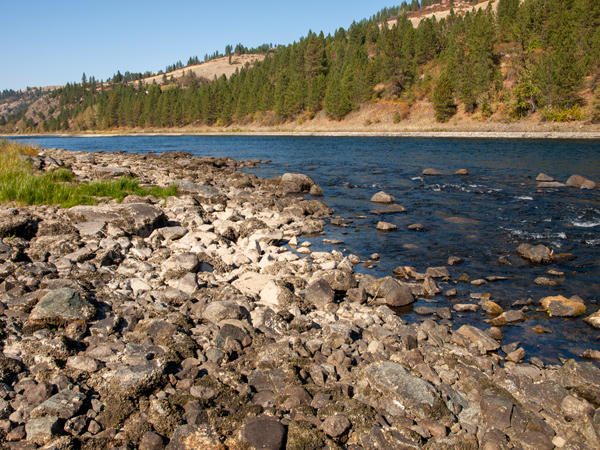Clearwater Canoe Camp, ID By the end of this day, all the canoes are ready to put into the water. After dark, the saddles and some ammunition are buried. Clark applies the name “Kos kos kee” also spelled Kooskooskee, to the present-day Clearwater River.
Kooskooskee River (Clearwater)
Clearwater Canoe Camp, Nez Perce National Historic Park, 11 October 2009. © by Kristopher K. Townsend. Permission to use granted under the Creative Commons Attribution-Share Alike 4.0 International license.
Another Cache[1]Originally aired weekdays by Yellowstone Public Radio during the Bicentennial observance of 2003-2006. Narrated by Hal Hansen. Scripts by Whit Hansen and Ed Jacobson. Produced by Leni Holliman. © … Continue reading
All Canoes Ready
we got oars and poles ready. towards evening we got the other canoes ready to put in the river. Some gig poles got ready.
—John Ordway
The Kooskooskee River
The river below this forks is Called Kos kos kee [Clearwater] it is Clear rapid with Shoals or Swift places—
The open Countrey Commences a fiew miles below This on each side of the river, on the Lard Side below the 1st Creek. with a few trees Scattered near the river.
—William Clark
Caching Saddles and Ammunition
had all our Saddles Collected a whole dug and in the night buried them, also a Canister of powder and a bag of Balls at the place the Canoe which Shields made was cut from the body of the tree— The Saddles were buried on the Side of a bend about ½ a mile below—
—William Clark
Celestial Observations
Took time and distance of moons Western Limb and α Arquile, Star West—
—William Clark
Lewis’s Specimens
In Washington City, Thomas Jefferson provides Charles Willson Peale an inventory of specimens shipped from Fort Mandan in the barge.
Washington Oct. 6. 05.
Dear Sir
I arrived here two days ago, & found the articles which had been forwarded by capt Lewis. there is a box of minerals which he particularly desired should go to the Philosophical society. there are some articles which I shall keep for an Indian Hall I am forming at Monticello, e.g. horns, dressed skins, utensils &c. and I am now packing up for you the following articles
- 2. skins of the white hare
- 2. skeletons of do. [ditto]
- a skeleton of the small or borrowing wolf of the prairies [badger]
- a male & female Blaireau or burrowing dog of the prairies with the skeleton of the female
- 13. red fox skins
- skins of the male & female antelope with their skeletons. [pronghorn]
- 2. skins of the burrowing squirrel of the prairies [prairie dog]
- a living burrowing squirrel of the prairies.
- a living magpie
- a dead one preserved.
Th: Jefferson[2]Letters of the Lewis and Clark Expedition with Related Documents: 1783-1854, 2nd ed., ed. Donald Jackson (Urbana: University of Illinois Press, 1978), 260–61.
Weather Diary
Day of the month Wind State of the Weather 6th E fair Note from the 1st to 7th of October we were at the mouth of Chopunnuish river makeing Canoes to Decend the Kooskooske.
—William Clark[3]Some abbreviations have been spelled out.
Notes
| ↑1 | Originally aired weekdays by Yellowstone Public Radio during the Bicentennial observance of 2003-2006. Narrated by Hal Hansen. Scripts by Whit Hansen and Ed Jacobson. Produced by Leni Holliman. © 2003 by Yellowstone Public Radio. |
|---|---|
| ↑2 | Letters of the Lewis and Clark Expedition with Related Documents: 1783-1854, 2nd ed., ed. Donald Jackson (Urbana: University of Illinois Press, 1978), 260–61. |
| ↑3 | Some abbreviations have been spelled out. |

